See my previous comment about "AIR" seat tubes. 2 designs were used.Columbus Air has an ovalised seat tube and a specific seatpost that goes with it. I can’t tell fully from the pics, but yours looks like it’s round. The fork crown looks more like it might be Columbus Max and the deep rear stays also look very Max. If you measure the ODs of the tubes you should be able to confirm this by comparing to the quoted dimensions of the tube set.
You are using an out of date browser. It may not display this or other websites correctly.
You should upgrade or use an alternative browser.
You should upgrade or use an alternative browser.
Olmo Columbus Air?
- Thread starter AJ 1967
- Start date
Jesper, thanks for the reply. Mine is a repaint. The down and seat tube are round. The seat stays are aero. The blue one is the only one I've found on the Internet with the same BB, lugs, rear brake bridge, fork crown and colour scheme is pictured. The only difference is the seat stays are chrome. Mine even has the same colour panto paint under the white on mine. The bike is stickered as Air, but I think that applies to the forks and stays only. The Brown one is looks as if it has regular SL stickers. Cromor has a stated tube weight of 2190g vs 1925g on SL. 265g difference. My overall frame weight of 2562, is commensurate with SL allowing for crown, BB lugs etc.
I think Cromor forks being chromoly are the same as air. Weight seems similar. I'll sticker mine similarly.

I think Cromor forks being chromoly are the same as air. Weight seems similar. I'll sticker mine similarly.
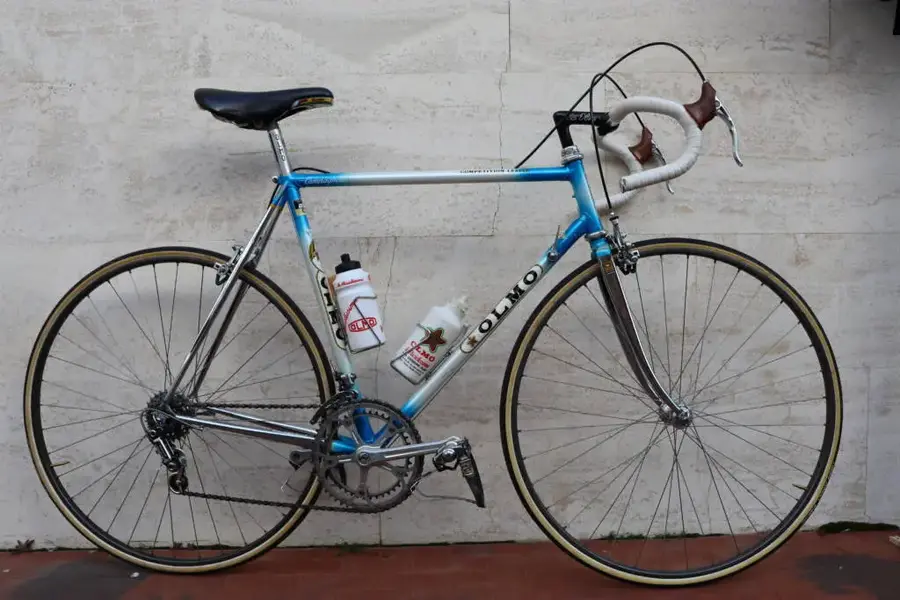
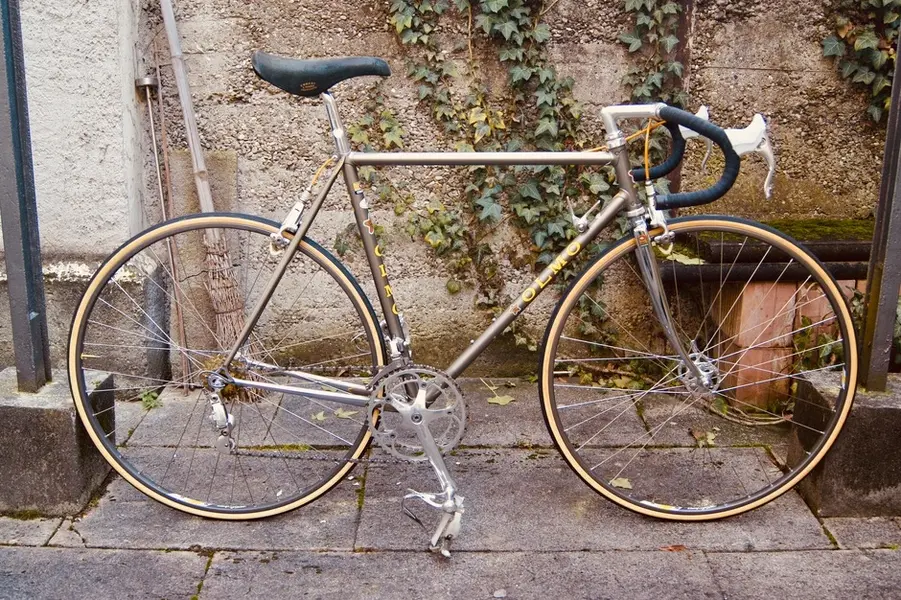
@AJ 1967 thanks for the comparisons. Unfortunately, I do not have an Olmo of that vintage; mine is c. 1978-'80. It is very difficult to judge by weight given that your frame is on the smaller side for sizing. I am pretty certain that the weights referenced were for a larger frame size (56cm?) and I know the weights were based on a raw uncut tubing set; even a larger frame might appear lighter depending on the final cut lengths of the tubes, and lugset/BB shell used. The fork crown is definitely of the same design I have used before, but again if the decals for the blades are original than "CROMOR" is quite plausible. I have seen other Olmo frames using "CROMOR" so it was not something alien to the company in its manufacture of different mid range models. "CROMOR" & "SL" both take 27.2mm posts as both seat tubes are drawn to .6mm wall thickness at the top, but "SL" has .9mm thickness at the butt, and "CROMOR" is 1.0mm at the butt (https://www.columbus1919.com/en/seat-tubes-2/).
I would suspect a "CROMOR" frame if no reinforcements (5 helical ridges) in the steerer tube, whereas "SL" frames had fork steerers with the ridges.
Olmo was known for making a wide range of bikes to meet certain price points so I am not surprised that they made an entry/mid level TT style frame during that era.
Regardless, it is a great frame. I liked my Olmo and I think it was "Aelle" tubing (or "SP") so definitely an entry-mid level and had the top of the line Galli components (as good as Campagnolo, and lighter weight).
I would suspect a "CROMOR" frame if no reinforcements (5 helical ridges) in the steerer tube, whereas "SL" frames had fork steerers with the ridges.
Olmo was known for making a wide range of bikes to meet certain price points so I am not surprised that they made an entry/mid level TT style frame during that era.
Regardless, it is a great frame. I liked my Olmo and I think it was "Aelle" tubing (or "SP") so definitely an entry-mid level and had the top of the line Galli components (as good as Campagnolo, and lighter weight).
Hey Jesper, you have pushed me to look harder at the Cromor option and I think I've found the evidence to rule that out. The Olmo Cromor frame was sold as the San Remo frame or Firenze Bike. It had round seat stays cheaper lugs and bottom bracket. So i'm confident it's not that. From a thread on Bike Forums it also had dual water bosses and a pump peg. I found a San Remo 53 cm for sale at that says it's 2.69Kg v 2.56 for mine. I suspect the Air fork is the same as the Cromor as those that I've found on line have the same weight and are both made of CroMo.
I'm now relatively convinced I have a Air / SL mix. Not that it matters much as Cromor is supposed to be almost as good as SL and the difference would be imperceptible to me. Do you know where I can find a 1985 SL datasheet with the tube profiles on it?
https://www.velosaloon.com/products/olmo-san-remo-53-cm-c-t-52-cm-c-c-columbus-cromor
I'm now relatively convinced I have a Air / SL mix. Not that it matters much as Cromor is supposed to be almost as good as SL and the difference would be imperceptible to me. Do you know where I can find a 1985 SL datasheet with the tube profiles on it?
https://www.velosaloon.com/products/olmo-san-remo-53-cm-c-t-52-cm-c-c-columbus-cromor
@AJ 1967 here is an "SL" chart I have, not sure of the year; but it is that general period given the single wing dove logo and spec'd weight. I would certainly check the steerer tube for the reinforcement ridges. I think that would tell you that it is "Air/SL" since the "CROMOR" steerer did not utilize those helical ridges (except possibly as an odd variant, as later explained).
I cannot disagree with you on your assessment. Tubing shape is important to help ID it, so great if that is the higher end stuff. If those "CROMOR" fork decals were not there or appeared to be new replacements it would ease my concerns about the tubing ID.
I have a "TSX" (their top of the line when introduced) frame that is the seamless tube like "SL" & "SLX" using the same "Cyclex" CrMo alloy, but Columbus also made a seamed "CROMOR" version of "TSX" also. It shows how willing they were to use unique features of one tube (full length helical reinforcing on "TSX") and incorporate into a slightly lower priced tube. That is another reason why there is a possibility that you have a "CROMOR" tubed frame that has the outward festures of "SL" and/or "AIR" tubes. Columbus did not make it easy on buyers; and the builders were able to use unique tubes to build models of a certain type of frame that would meet different price points for the buyers. Not much different than Campagnolo making the same version of the "Record" front derailleur, but having anodized a couple pieces black and calling it "Super Record" to sell at a higher price while it performed and weighed the same as the less expensive unit. It is all about marketing and giving buyers options to fit their wallets. As I have firm proof that the "CROMOR" can be shaped to the same degree as the "GILCO S4" tubing, and like "CROMOR" can be reinforced the same as the "TSX" tubing makes it difficult to differentiate after the fact what a specific builder did or did not do when making their models. I still would not get to hung up on weight, it one of the least accurate means to identify a bike's actual tubeset unless you have an identical frame size with identical fittings, paint and chrome, and weighed on the same scale. At least you can be sure that you have a quality lightweight frame that should perform excellently when built uo regardles of what decals get put on it. I have frames that I have never been able to identify the tubing on. It most likely is "SL", but no way to tell for sure given other tube makers copied tube profiles just like builders copied frame geometries.
If I had not already had dozens of odd frames pass through my hands it would be easier for me to accept things a little more at "face value"; but my skeptism and wariness are based upon decades of experience where I am often surprised to find out something I never would have believed even if I had know it at the very start. It's all good in the end if your are satisfied with the outcome. A little mystery is not always a bad thing. Often it's good conversation point just like this thread is. I am still hoping you find definitive proof either way since it would then help educate me also as this conversation already has done.
"SL" '80s ("SL" used to be spec'd heavier [2065g] in earlier catalogs and that is how I know that this is appropriate to the era of your frame. Weight was reduced from earlier tubeset version due to shorter butt lengths)

From Feb. 1996 "Bicycle Guide" mag.; shows "CROMOR", but not "SL"

"TSX", and "TSX/CROMOR"


I cannot disagree with you on your assessment. Tubing shape is important to help ID it, so great if that is the higher end stuff. If those "CROMOR" fork decals were not there or appeared to be new replacements it would ease my concerns about the tubing ID.
I have a "TSX" (their top of the line when introduced) frame that is the seamless tube like "SL" & "SLX" using the same "Cyclex" CrMo alloy, but Columbus also made a seamed "CROMOR" version of "TSX" also. It shows how willing they were to use unique features of one tube (full length helical reinforcing on "TSX") and incorporate into a slightly lower priced tube. That is another reason why there is a possibility that you have a "CROMOR" tubed frame that has the outward festures of "SL" and/or "AIR" tubes. Columbus did not make it easy on buyers; and the builders were able to use unique tubes to build models of a certain type of frame that would meet different price points for the buyers. Not much different than Campagnolo making the same version of the "Record" front derailleur, but having anodized a couple pieces black and calling it "Super Record" to sell at a higher price while it performed and weighed the same as the less expensive unit. It is all about marketing and giving buyers options to fit their wallets. As I have firm proof that the "CROMOR" can be shaped to the same degree as the "GILCO S4" tubing, and like "CROMOR" can be reinforced the same as the "TSX" tubing makes it difficult to differentiate after the fact what a specific builder did or did not do when making their models. I still would not get to hung up on weight, it one of the least accurate means to identify a bike's actual tubeset unless you have an identical frame size with identical fittings, paint and chrome, and weighed on the same scale. At least you can be sure that you have a quality lightweight frame that should perform excellently when built uo regardles of what decals get put on it. I have frames that I have never been able to identify the tubing on. It most likely is "SL", but no way to tell for sure given other tube makers copied tube profiles just like builders copied frame geometries.
If I had not already had dozens of odd frames pass through my hands it would be easier for me to accept things a little more at "face value"; but my skeptism and wariness are based upon decades of experience where I am often surprised to find out something I never would have believed even if I had know it at the very start. It's all good in the end if your are satisfied with the outcome. A little mystery is not always a bad thing. Often it's good conversation point just like this thread is. I am still hoping you find definitive proof either way since it would then help educate me also as this conversation already has done.
"SL" '80s ("SL" used to be spec'd heavier [2065g] in earlier catalogs and that is how I know that this is appropriate to the era of your frame. Weight was reduced from earlier tubeset version due to shorter butt lengths)
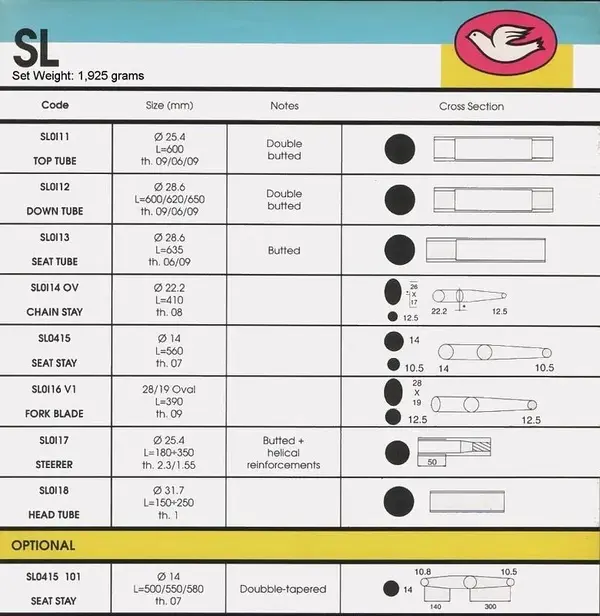
From Feb. 1996 "Bicycle Guide" mag.; shows "CROMOR", but not "SL"
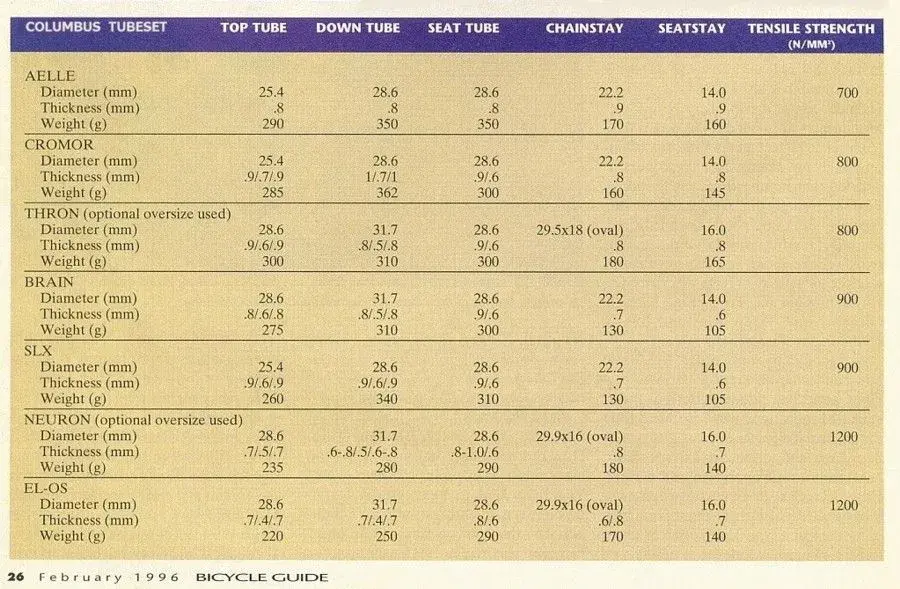
"TSX", and "TSX/CROMOR"
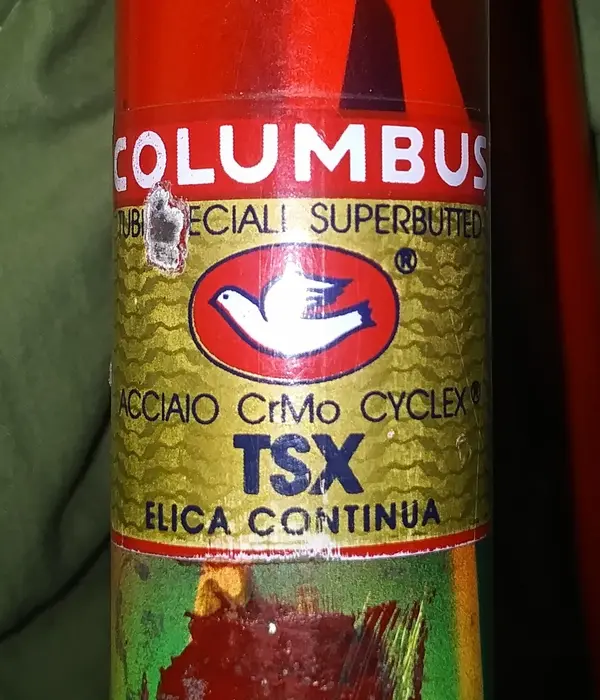
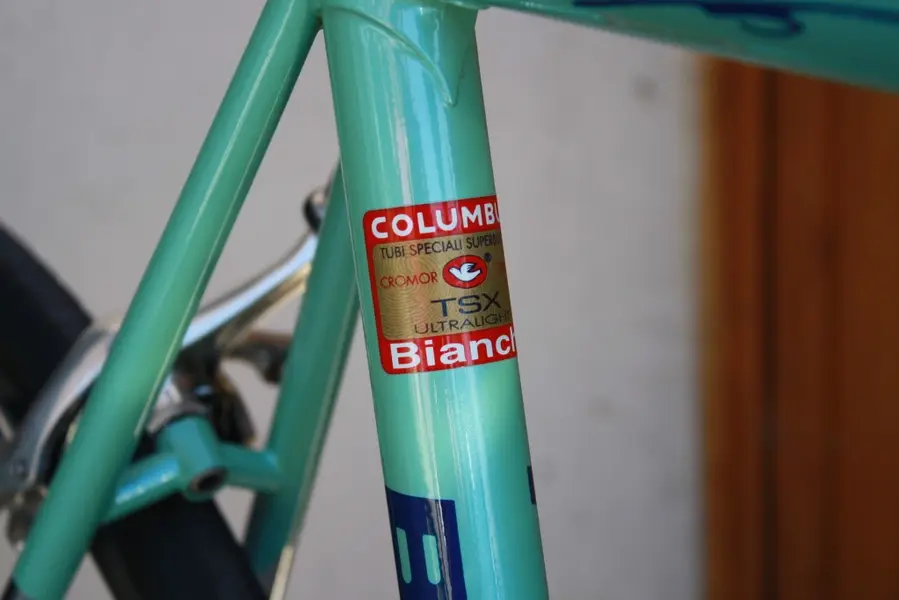
Last edited:
Definitive proof I think is mission impossible, this is more Sherlock Holmes ...... deduction!
...... more sleuthing!
The Olmo model with Cromor is The San Remo which didn't feature serial numbers or aero stays. So that's out. I can't find any custom builds with Cromor.
From a post I found on Bike Forums regarding somebody's San Remo from T-Mar. "It looks like your frame has a Columbus Cromor decal. If so, and providing it's OEM, your bicycle isn't any earlier than a 1987 model. Cromor didn't exist in 1985 or 1986. Prior to 1987, Cromor had been called Matrix but Trek launched legal action, as it infringed on their Matrix rims. As a result, Columbus Matrix was renamed Columbus Cromor sometime during the 1987 model year. The Columbus decal layout was revised for the 1988 model year and your frame does not wear the revised version but manufacturers often had old stock to use up, so a 1988 model would also have a relatively high probability."
My paint scheme was associated with frames earlier, though it has a repaint sticker.
In the 1985 catalogue (No air listed) the San Remo was listed as having Columbus CroMo tubes but round stays. I could have an iteration of air that included Air forks and stays with round CroMo triangle. And here is an example, albeit with the aero deraileur shifter mount. https://www.peterbrueggeman.com/cr/catalogues/olmo-ssn-bike6735-romag-dot-loren.pdf
https://www.peterbrueggeman.com/cr/catalogues/olmo-ssn.htm
The steerer tube doesn't have ridges and the Columbus Air Fork is a Cromo fork so that's consistent.
And with this .... https://www.registrostoricocicli.com/rsc/registro-altre-marche/olmo-005/..... being the same as mine, I'm done sleuthing Dr Watson. It's an Olmo Competition Leader with Columbus Air tubes.
...... more sleuthing!
The Olmo model with Cromor is The San Remo which didn't feature serial numbers or aero stays. So that's out. I can't find any custom builds with Cromor.
From a post I found on Bike Forums regarding somebody's San Remo from T-Mar. "It looks like your frame has a Columbus Cromor decal. If so, and providing it's OEM, your bicycle isn't any earlier than a 1987 model. Cromor didn't exist in 1985 or 1986. Prior to 1987, Cromor had been called Matrix but Trek launched legal action, as it infringed on their Matrix rims. As a result, Columbus Matrix was renamed Columbus Cromor sometime during the 1987 model year. The Columbus decal layout was revised for the 1988 model year and your frame does not wear the revised version but manufacturers often had old stock to use up, so a 1988 model would also have a relatively high probability."
My paint scheme was associated with frames earlier, though it has a repaint sticker.
In the 1985 catalogue (No air listed) the San Remo was listed as having Columbus CroMo tubes but round stays. I could have an iteration of air that included Air forks and stays with round CroMo triangle. And here is an example, albeit with the aero deraileur shifter mount. https://www.peterbrueggeman.com/cr/catalogues/olmo-ssn-bike6735-romag-dot-loren.pdf
https://www.peterbrueggeman.com/cr/catalogues/olmo-ssn.htm
The steerer tube doesn't have ridges and the Columbus Air Fork is a Cromo fork so that's consistent.
And with this .... https://www.registrostoricocicli.com/rsc/registro-altre-marche/olmo-005/..... being the same as mine, I'm done sleuthing Dr Watson. It's an Olmo Competition Leader with Columbus Air tubes.
All the Columbus top end tubes of the era that were CrMo ended up being termed "Cyclex" (a patented name, sometime in the mid '80s); later tubes with the same model names (e.g. "SL", "CROMOR", et al.) were made from a new CrMo alloy called "Omnicrom" (I think fairly recently c.2020), "Nivacrom" was another patented name for their next CrMo alloy from late '80s into the '90s and beyond. I do not not know if "Cyclex" steel is still used by Columbus today in bicycle tubing applications.
I have verified that the "AIR" fork steerer tube did have ridges on it. It was probably identical to the "SL", et al. steerer since there was no change in the alloy, and of course no manipulation of its shape; although the wall thicknesses and butt length may have differred from "SL" steerer. The fact that your steerer has no ridges again calls into question its actual model (complete "CROMOR" fork; hybrid fork with "CROMOR" steerer and "AIR" blades, etc.).
I would love to trust empirical data provided by maufacturers and examples given by themselves and owners; but there are, in my experience, many outliers that contradict what is documented (Colnagos and Rossin are a prime example). Many times in post catalog publication/mid-model year changes are made and variants to models are produced that are never reflected in documentation by the manufacturer and are sometimes due to relieving themselves of odd or old stock materials, and that are made in very small quantities and are not continued into the next model year's line-up. Who knows? It happens with framebuilders working in large and small companies, as well as component manufactuers. I have a bespoke frame made in 1986 from tubing (Reynolds Special Lightweight) that was discontinued nearly 8 years or more earlier so nothing surprises me at this point.
I can only hope that you (or myself) find an identical example with its original livery intact showing marque & model decals, as well as tubing decals. That will probably be the only way to clear up the mystery and allow you a means to accurately install the proper decals, and from then on be able to describe the bike with the confidence knowing that no assumptions are being made regarding its identification.
I am making notes in my Olmo entry for my Italian bikes reference database with everything you have discovered, and I will annotate the entry as an "open case" still needing further investigation.
To just clarify; you have found no serial number or other distinct marking on the frame or steerer tube (sometimes there is the frame manufacturer's mark there aside from the tubing manufacturer's stamp).
Again, I will not disagree with your assessment based on the example you have found, but I cannot, at this time, satisfy myself 100% based on the existing anomaly of the smooth steerer tube on an "AIR" fork. If I find another known "AIR" frameset using a smooth steerer tube on its fork then I will assume that at some time Columbus created a variant fork set, or builders themselves possibly used a different steerer tube to provide a different ride quality from the helical ridged reinforced steerer tube since I doubt that one detail would have been much of a cost difference.
Not sure that I can add any more to help, but if I do discover something else I will provide you with the details.
I have verified that the "AIR" fork steerer tube did have ridges on it. It was probably identical to the "SL", et al. steerer since there was no change in the alloy, and of course no manipulation of its shape; although the wall thicknesses and butt length may have differred from "SL" steerer. The fact that your steerer has no ridges again calls into question its actual model (complete "CROMOR" fork; hybrid fork with "CROMOR" steerer and "AIR" blades, etc.).
I would love to trust empirical data provided by maufacturers and examples given by themselves and owners; but there are, in my experience, many outliers that contradict what is documented (Colnagos and Rossin are a prime example). Many times in post catalog publication/mid-model year changes are made and variants to models are produced that are never reflected in documentation by the manufacturer and are sometimes due to relieving themselves of odd or old stock materials, and that are made in very small quantities and are not continued into the next model year's line-up. Who knows? It happens with framebuilders working in large and small companies, as well as component manufactuers. I have a bespoke frame made in 1986 from tubing (Reynolds Special Lightweight) that was discontinued nearly 8 years or more earlier so nothing surprises me at this point.
I can only hope that you (or myself) find an identical example with its original livery intact showing marque & model decals, as well as tubing decals. That will probably be the only way to clear up the mystery and allow you a means to accurately install the proper decals, and from then on be able to describe the bike with the confidence knowing that no assumptions are being made regarding its identification.
I am making notes in my Olmo entry for my Italian bikes reference database with everything you have discovered, and I will annotate the entry as an "open case" still needing further investigation.
To just clarify; you have found no serial number or other distinct marking on the frame or steerer tube (sometimes there is the frame manufacturer's mark there aside from the tubing manufacturer's stamp).
Again, I will not disagree with your assessment based on the example you have found, but I cannot, at this time, satisfy myself 100% based on the existing anomaly of the smooth steerer tube on an "AIR" fork. If I find another known "AIR" frameset using a smooth steerer tube on its fork then I will assume that at some time Columbus created a variant fork set, or builders themselves possibly used a different steerer tube to provide a different ride quality from the helical ridged reinforced steerer tube since I doubt that one detail would have been much of a cost difference.
Not sure that I can add any more to help, but if I do discover something else I will provide you with the details.
Last edited:
T Mar on Bike forums previously confirmed that Some Air forks did not have the ridges. Do you know him? But the weight is critical in ruling Cromor out. The frame weight makes it impossible to be Cromor.
Here is an eBay link for some similar forks https://www.ebay.co.uk/itm/165382777952 779 grams (long steerer tube. Mine are 637 with the steerer tube bottom bung.
Using Framebuilders supply for weights:
https://framebuildersupply.com/ Max are 362g (pair) untrimmed.
My bike has the frame number stamped on the BB & Steerer tube. It's the Cromor bikes that don't have a frame number.
Regarding the spirals here's a couple of quotes
"Don't go by spirals at the bottom of the fork steerer tube as pretty much all Columbus tube sets had that."
"A tretubi frame is a frame that uses the designated tubing only in the main triangle with lesser grade material in the stays and forks. SL tretubi is the most common tretubi configuration. An SL tretubi frame would have an SL main triangle. The stay and forks would be a lesser grade. Typically they would be one step down but could be anything, even from another manufacturer."
This reinforces my opinion that it's an SL / AIR mix. It's not heavy enough to be one of the CroMo variants.
Here is an eBay link for some similar forks https://www.ebay.co.uk/itm/165382777952 779 grams (long steerer tube. Mine are 637 with the steerer tube bottom bung.
Using Framebuilders supply for weights:
| Cromor | SL | |
| Steerer tube 180 = 186g | 140 | 140 |
| dropouts | 37 | 37 |
| blades | 391 Cromor | 336 SL |
| crown | 145 | 145 |
| total | 713 | 658 |
My bike has the frame number stamped on the BB & Steerer tube. It's the Cromor bikes that don't have a frame number.
Regarding the spirals here's a couple of quotes
"Don't go by spirals at the bottom of the fork steerer tube as pretty much all Columbus tube sets had that."
"A tretubi frame is a frame that uses the designated tubing only in the main triangle with lesser grade material in the stays and forks. SL tretubi is the most common tretubi configuration. An SL tretubi frame would have an SL main triangle. The stay and forks would be a lesser grade. Typically they would be one step down but could be anything, even from another manufacturer."
This reinforces my opinion that it's an SL / AIR mix. It's not heavy enough to be one of the CroMo variants.
When you click on links to various merchants on this site and make a purchase, this can result in this site earning a commission. Affiliate programs and affiliations include, but are not limited to, the eBay Partner Network.
Again, not disagreeing with your assessment. I am certainly aware of framesets not using a full "type" ("SL" or otherwise) set of tubes. A full "SL" frameset (frame and fork) would have the helical ridges. Many builders would use a completely different fork (no Columbus components), and/or a mix. Same as in the frame itself. Somtimes done for performance/function reasons (stiffer, heavier duty, etc ), and sometimes as a cost savings measure.
I will contact Tom (whose knowledge and experience I respect) regarding the "AIR" tubeset spec'd as having the ridges, no ridges, as a factory option, or as a builder's choice not relating directly to the Columbus spec'd "AIR" steerer. I am trying to educate myself regarding what I do not know about this tubeset, and I will be interested to get some more solid facts about it. It seems I will have to contact Columbus directly and see if they will forward a spec sheet on the tubeset to clear up these questions. I do not know except that I asked an owner what their bike had. Now I will ask more to see if it varied. It should be specified by Columbus (as it is with the "SL" set) as to whether it was part of the tubeset or an optional selection. I could not find an "AIR" spec sheet showing anything other than tube shape descriptions (no raw lengths, butt lengths, wall thicknesses, extra reinforcements, etc.). I found a reply posed by a friend who was told that the down tube had an internal sleeve to increase stiffness (from a Trek builder in the 80s); but again, I have not seen that referenced by Columbus anywhere as of yet.
I will contact Tom (whose knowledge and experience I respect) regarding the "AIR" tubeset spec'd as having the ridges, no ridges, as a factory option, or as a builder's choice not relating directly to the Columbus spec'd "AIR" steerer. I am trying to educate myself regarding what I do not know about this tubeset, and I will be interested to get some more solid facts about it. It seems I will have to contact Columbus directly and see if they will forward a spec sheet on the tubeset to clear up these questions. I do not know except that I asked an owner what their bike had. Now I will ask more to see if it varied. It should be specified by Columbus (as it is with the "SL" set) as to whether it was part of the tubeset or an optional selection. I could not find an "AIR" spec sheet showing anything other than tube shape descriptions (no raw lengths, butt lengths, wall thicknesses, extra reinforcements, etc.). I found a reply posed by a friend who was told that the down tube had an internal sleeve to increase stiffness (from a Trek builder in the 80s); but again, I have not seen that referenced by Columbus anywhere as of yet.
Similar threads
- Replies
- 4
- Views
- 508
- Replies
- 17
- Views
- 2K
- Replies
- 20
- Views
- 2K
- Replies
- 9
- Views
- 517